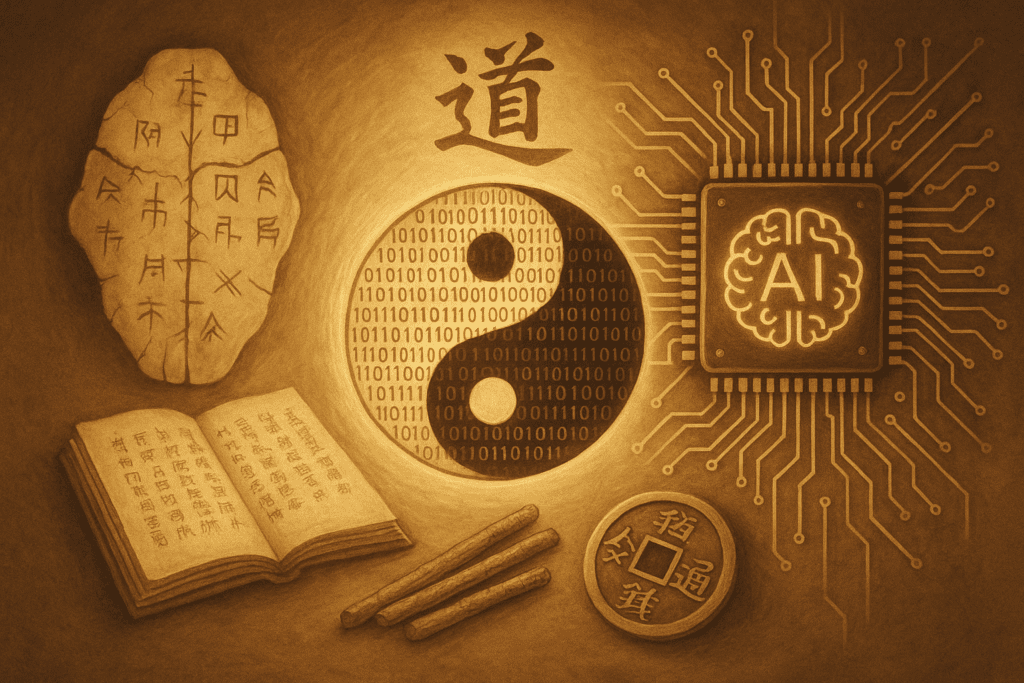In the heart of ancient China, wise sages inscribed questions to the universe on oracle bones, seeking wisdom from the mysterious forces governing life. Centuries later, the philosopher Lao Tzu penned the iconic words in the Tao Te Ching: “The Tao that can be told is not the eternal Tao.” This profound idea—that the fundamental truth of the universe transcends form yet manifests in countless ways—resonates powerfully today, especially as modern technology reimagines ancient practices of seeking meaning. Take YOWAYOW, an innovative platform that uses artificial intelligence to interpret the I Ching (Book of Changes), the oldest and most revered divination text in Chinese philosophy. While the method has evolved from cracking turtle shells to coding algorithms, the essence of humanity’s quest to understand the “Tao”—the unnameable principle underlying all existence—remains unchanged.
The Eternal Tao: Beyond Form, Yet In All Forms
Lao Tzu’s wisdom reminds us that while we strive to describe the universe’s ultimate truth through words, rituals, or technologies, the “Tao” itself is eternal. In the I Ching, this concept takes shape through 64 hexagrams, symbolizing the interplay of yin and yang. For millennia, seekers meditated on these symbols to gain insight into life’s challenges—a practice of inner reflection that aligned them with natural rhythms.
Today, that ancient practice finds new form in digital tools. Such platforms use machine learning to analyze user queries and generate hexagram interpretations, connecting classical texts to modern dilemmas with surprising nuance. For example, a career change query might evoke Hexagram 49, “Revolution,” explaining how upheaval fosters growth—mirroring traditional divination, yet delivered with the speed and accessibility of a tool designed for today’s fast-paced world. Skeptics may question algorithmic interpretations, but as Lao Tzu taught, the Tao adapts: it flowed through Shang dynasty oracle bones and Tang dynasty calligraphy, and now through the code of platforms that honor its timeless wisdom. The form changes, but the purpose—fostering understanding and harmony—endures.
Where Ancient Wisdom Meets Digital Innovation
What makes such initiatives compelling is their ability to weave tradition into innovation without losing depth. Developers spent years curating a vast database of classical commentaries, from the original Zhou dynasty texts to Carl Jung’s psychological insights into the I Ching as a mirror of the collective unconscious. When users engage with the AI, they’re not just accessing a digital tool; they’re entering a dialogue with 3,000 years of human wisdom, reimagined to address 21st-century concerns like career burnout, relationship complexities, and existential uncertainty.
Consider Sarah, a Silicon Valley software engineer who turned to such a platform during a period of overwhelming stress. Feeling adrift in a culture that equated productivity with worth, she posed a simple question about finding balance. The AI generated Hexagram 15, “Modesty,” with a commentary that spoke not of weakness, but of the strength in recognizing limits—a gentle reminder that harmony begins with self-awareness. Sarah later noted that the experience felt less like algorithmic fortune-telling and more like a quiet conversation with an ancient mentor, updated for a world where screens are as much a part of daily life as sacred texts once were.
Why This Matters for Modern Seekers
In a world dominated by instant answers and relentless progress, the I Ching‘s enduring appeal—amplified by such innovations—lies in its emphasis on process over prediction. These tools don’t claim to decode the future; instead, they invite users to slow down, reflect on their questions, and find meaning in the interplay between human curiosity and universal principles. This mirrors Lao Tzu’s core teaching: the Tao resists being confined by definitions or forms, revealing itself only to those willing to engage with mystery as much as logic.
For American readers, raised in a culture that values both technological ingenuity and pragmatic solutions, this offers a unique synthesis: ancient philosophy not as an artifact of the past, but as a living, evolving companion for the present. Whether we’re interpreting cracks on a turtle shell or patterns in a dataset, we’re participating in a dialogue as old as humanity—one that asks us to acknowledge what we don’t know, trust the rhythms of change, and seek balance in a world of constant flux.
Conclusion: The Tao Flows On
As we navigate the digital age, Lao Tzu’s wisdom stands as a timeless anchor: while the vessels may change—from oracle bones to algorithms—the river of wisdom flows on. Platforms like the one embracing I Ching insights remind us that technology can be a bridge, not a barrier, connecting us to the deepest questions of meaning, purpose, and harmony that have guided humans across millennia. The Tao that once whispered through bamboo texts now speaks in the language of code, yet its message remains unchanged: in the dance between old and new, form and formlessness, the eternal truth persists—waiting for those who seek to listen, reflect, and walk their path with clarity.
